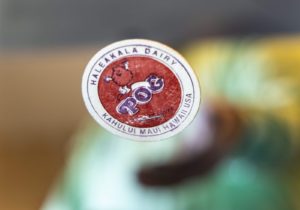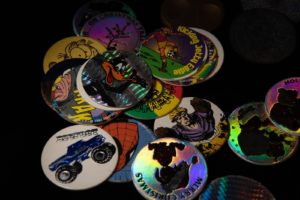Every so often, a toy or other children’s item grasps the attention of consumers (children and otherwise) so fiercely that a mania ensues. We’ve seen this many times before – from Pet Rocks and Furbies, to Beanie Babies and Tamagotchis. Sometimes these items will see a revival years later, as was the case with Pokémon cards; sometimes the items will disappear completely so that we almost forget the mania around it ever even happened.
Such was the case with POGs.
And yet, for a few glorious years in the mid-1990s the wafer-like discs known as POGs dominated the collective consciousness of children across America.
Let’s take a look back…
The Origin of the POG
Long before POGs and the 1990s, there were milk caps. Often emblazoned with a dairy’s logo, children in Hawaii would play a game with these caps, stacking them and knocking them down in a contest derived from the old Japanese card game Menko. A trendy game to play during the Depression, it was essentially forgotten once milk caps fell out of favor in the 1950s. But two decades later a Maui company, Haleakala Dairy, would revive these little cardboard discs and the game they spawned.

Released as a promotional freebie for Haleakala’s latest product, Passion Orange Guava, these new caps found their way onto Hawaiian playgrounds in the late 1980s. In perhaps an apocryphal tale, the origin story of POGs suggests that a school teacher, Blossom Galbiso, is to blame for the milk cap game going viral. As the story goes, Galbiso had been exposed to the game as a child through her grandparents, who had played it with milk caps when they worked on plantations decades earlier. Seeing an opportunity to introduce her students to a non-violent game, Galibriso used the Passion Orange Guava caps to teach kids the milk cap game. And as Passion Orange Guava does not exactly roll off the tongue, these caps and their associated game were given the moniker POGs – an acronym that stuck.
POG Pandemonium
After seeing a news report about the milk cap craze in Hawaii, a Californian businessman saw an opportunity to make some serious cash. An investor with a keen eye for potential, Alan Rypinksi had made his fortune in the 1970s selling the all-purpose car cleaning product, Armor All. After some digging around to discover that STANPAC, Haleakala’s milk cap producer, could not keep up with the influx of orders for more caps – Rypinski stepped in.
Moving quickly, he bought the POG trademark from Haleakala Dairy. Focusing on the marketing potential of the caps, Rypinski developed his own business to sell officially licensed POGs – bringing the modern milk caps stateside. This company, the World POG Federation, was instantly big business. They experienced explosive growth, and by their second year sales exceeded $175 million.
Keen to keep profits up, the World POG Federation inked licensing deals with several major companies, like Disney, Nintendo and Wal-Mart. They wanted POGs in the pockets of every child in America, and for a few years they succeeded. These little cardboard wafers were no longer some small-time fad but a bona-fide cash cow.

Milking the hype, The World POG Federation started hosting an annual U.S. National POG Tournament, which sparked smaller regional and local tournaments to pop up across the country. When POG hype was at its peak in 1994 and 1995, stores could not keep POGs on the shelves and could not restock fast enough. Demand was so great that it is estimated sales peaked at roughly $10 million a week.
Beyond the demand for POGs, their ubiquity in this era is somewhat mind-boggling. Fox promoted a new animated television show, The Tick, through the distribution of POGs. McDonald’s offered Power Rangers “Power Coin” POGs in their Happy Meals. Blockbuster handed out POGs with VHS Rentals and Pixar even marketed a little movie called Toy Story by harnessing their power. The anti-drugs organization D.A.R.E. tossed them to participants at school events and even the Pope could not resist handing out POGs to the faithful while on a visit to the States.
There were POGs to hit every cultural note of the 1990s: aliens, yin-yang, cartoons, sports teams, sarcastic phrases, tie-dye, the Chicago Bulls, animated fruits, and even President Bill Clinton.
There were also knock-off POGs. As they were easy to distribute and cheap to produce, POGs were a natural advertising goldmine, and everyone got in on the game. By 1995, nearly every brand, band, hobbyist, artist and company under the sun was making some version of POGs. Even the World POGs Federation helped these homemade brews flourish by introducing a device that allowed you to make your own POGs at home using any imagery you so desired.
Variation abounded, as designs grew more and more complicated in an effort to stand out against the tide of other options. Knock-off brands sprouted up, like Tonx. Some brands added sparkles or holograms, others had shaped edges and cutouts. What made them so appealing was also what would lead to their eventual downfall: anyone could make cardboard discs covered in pictures and logos.
The Fall of POGs
Between the wheeling and dealing of the World POG Federation and the plethora of cheap imitations available, the market for POGs was quickly saturated. Brands kept on pumping out these marketing medallions, but by the mid 90s their appeal was beginning to wane.
The ultimate demise of POGS was also helped along by the banning of the game in some schools, as the game was deemed to be too much like gambling. To play the 1990s version of POGs, players would create stacks of POGs with each player contributing an equal stake of POGs from their own stash. Players would then alternate throwing their slammers (thicker and heavier discs) into the stack, hoping to jolt some POGs loose. Those POGs that landed face up became the property of the player that knocked them loose. Rinse, restack, repeat – until there were no POGs left to stack.
Kids would often play for keeps, meaning that any POGs risked in the game could be lost to another player. As kids not only played with POGs but also collected them, many adults concluded this was too much like gambling to be allowed in schools. Once the game was broadly banned, the craze died down.
The World POG Federation started its death keel in 1995, as the company faced bankruptcy. Rapidly downsizing to free up cash, Rypinksi sold control of the company to Pacific Capital Group. Desperately trying to save the business, they further cut staff and changed the company’s name, but neither could stop the bleeding.
Shortly thereafter the World POG Federation was officially shuttered. Other companies that produced POGs quickly followed suit. By 1998, POGs had fizzled out and children had moved on to other trends. By the turn of the century POGs were all but forgotten.
POGs have experienced a few minor resurgences in the intervening decades, but have never come close to reaching their peak. Looking back on them now they feel like a Millennial fever dream, as it is almost hard to believe a whole generation ever went that wild for pieces of cardboard.
Oh, wait… Never mind.

